Longwood Gardens Part 5: Tulips and Natives
Carolyn’s Shade Gardens is a retail nursery located in Bryn Mawr, PA, specializing in showy, colorful, and unusual plants for shade. The only plants that we ship are snowdrops and miniature hostas. For catalogues and announcements of events, please send your full name, location, and phone number (for back up use only) to carolyn@carolynsshadegardens.com. Click here to get to the home page of our website for catalogues and information about our nursery and to subscribe to our blog.
.  This color combination is magnificent for spring.
This color combination is magnificent for spring.
.
During 2012 to 2013, I have been visiting Longwood Gardens in Kennett Square, Pennsylvania, U.S., every few months and highlighting some aspect of this amazing place (last year I focused on Chanticleer). Links to my previous four posts are at the end. There is much to see there with 325 acres open to the public and 20 outdoor gardens.
On April 18, Michael and I headed out to Longwood with the specific objective of photographing the plants in the native woodland, Peirce’s Woods. Of course, on the way to the woods, we got sidetracked by the bulb displays out front and along the Flower Garden Walk. Although masses of tulips and other bulbs are just about polar opposite to native plants naturalized in a woodland, they are still gorgeous so I will show you a few photos as I explain the history of the woodland.
.
 Summer snowflake, Leucojum aestivum, is a great plant for massing. Mine grow and self-sow quite readily in both south-facing and east-facing locations as well as in full deciduous shade in my woodland.
Summer snowflake, Leucojum aestivum, is a great plant for massing. Mine grow and self-sow quite readily in both south-facing and east-facing locations as well as in full deciduous shade in my woodland.
In 1700, a Quaker family named Peirce purchased the area that is now Peirce’s Woods from William Penn to establish a working farm. In 1798, the Peirces began planting trees to establish an arboretum on the property. Eventually the area became known as one of the finest collections of trees in the country. The great industrialist Pierre DuPont (1870 to 1954) purchased the property in 1906 with the specific purpose of preserving the magnificent trees.
.
 You will find fabulous container gardens throughout Longwood, including this one outside the Visitor’s Center with a large native dogwood underplanted with daffodils.
You will find fabulous container gardens throughout Longwood, including this one outside the Visitor’s Center with a large native dogwood underplanted with daffodils.
Peirce’s Woods comprises seven acres planted to showcase the ornamental characteristics of native plants from the eastern U.S. deciduous forest. The shade trees are mostly oak, ash, maple, and tulip trees, some over 200 years old. The understory is native flowering trees and shrubs underplanted with native groundcovers. All the plants are labeled so it is a great place to visit to get ideas for your own woodland garden. Before I highlight the plants there, a few more bulb photos:
.
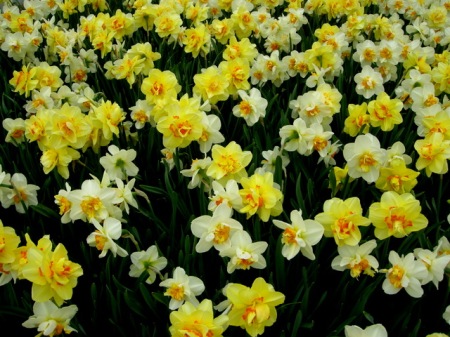 Narcissus ‘Tahiti’ and ‘Flower Drift’
Narcissus ‘Tahiti’ and ‘Flower Drift’
.
.
.
.
.
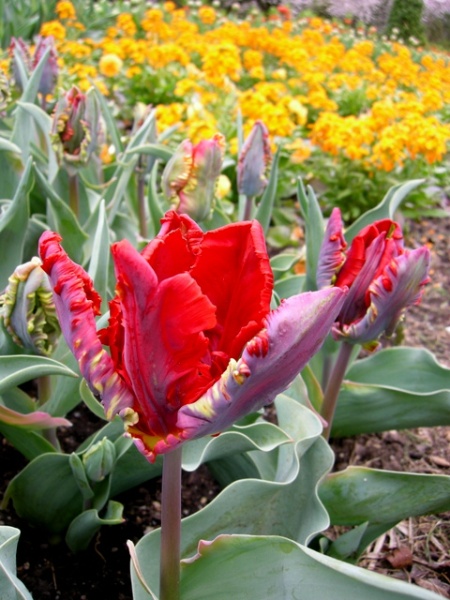 I think this tulip should be called the Little Shop of Horrors tulip—you definitely would not want to stick your finger inside of it.
I think this tulip should be called the Little Shop of Horrors tulip—you definitely would not want to stick your finger inside of it.
.
 As we neared the end of the Flower Garden Walk, we were greeted by this magnificent vista.
As we neared the end of the Flower Garden Walk, we were greeted by this magnificent vista.
We came to Longwood with the objective of viewing and photographing Peirce’s Woods. I fully intended to show scenes of the woods as a whole and close ups of individual native wildflowers. However, I didn’t realize that because the weather has been so cold this spring, many of the flowers would not be blooming yet. My own garden is always ahead because it is on a south-facing slope and the soil warms up early. Also, as soon as we got there and typical for this spring, the sun went in, the wind picked up, it started to rain, and the temperature plummeted.
.
 The only other landscape shot that I got: ostrich ferns by the shore of the lake. These ferns can be quite tall, 3 to 5′, spread aggressively by runners, and are the source of edible fiddleheads.
The only other landscape shot that I got: ostrich ferns by the shore of the lake. These ferns can be quite tall, 3 to 5′, spread aggressively by runners, and are the source of edible fiddleheads.
Michael and I were both under-dressed with no raincoats so I decided to take photos of the plants that were blooming and come back the following week for the landscape shots and later-blooming plants. As usual, work at the nursery got in the way, but I wanted to show you the beautiful native plants that I was able to capture on film. Just picture me kneeling patiently by each plant and snapping the photo in between gusts of wind and bouts of rain:
.
 ‘Miracle’ coralbells, Heuchera villosa, is one of my favorite cultivars of this tough eastern native. The only coralbells I sell at my nursery are offspring of eastern natives H. villosa and H. americana because I find the other types not hardy.
‘Miracle’ coralbells, Heuchera villosa, is one of my favorite cultivars of this tough eastern native. The only coralbells I sell at my nursery are offspring of eastern natives H. villosa and H. americana because I find the other types not hardy.
.
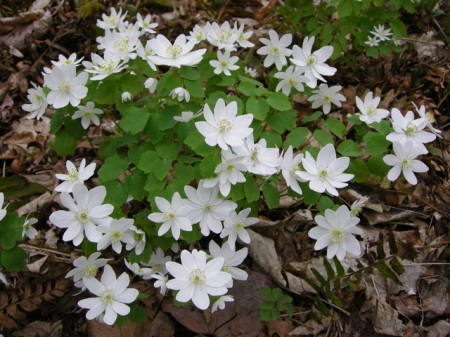 Rue-anemone, Anemonella thalictroides, is so delicate looking but thrives and self-sows in dry shade.
Rue-anemone, Anemonella thalictroides, is so delicate looking but thrives and self-sows in dry shade.
.
 ‘Quicksilver’ large-flowered trillium, T. grandiflorum, was selected as a rapidly multiplying form of the species by Dr. Richard Lighty, at the Mt. Cuba Center in Delaware.
‘Quicksilver’ large-flowered trillium, T. grandiflorum, was selected as a rapidly multiplying form of the species by Dr. Richard Lighty, at the Mt. Cuba Center in Delaware.
.
 ‘Quicksilver’ surrounded by rue-anemone.
‘Quicksilver’ surrounded by rue-anemone.
.
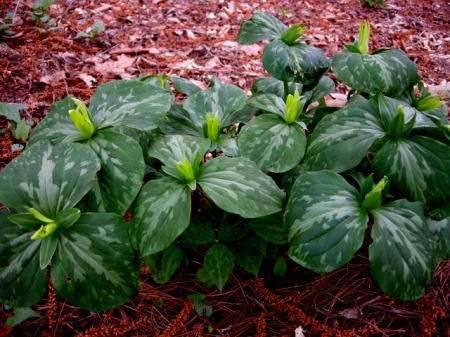 I find yellow toad trillium, T. luteum, quite easy to grow.
I find yellow toad trillium, T. luteum, quite easy to grow.
.
.
 The two-tone flowers of purple trillium are gorgeous.
The two-tone flowers of purple trillium are gorgeous.
.
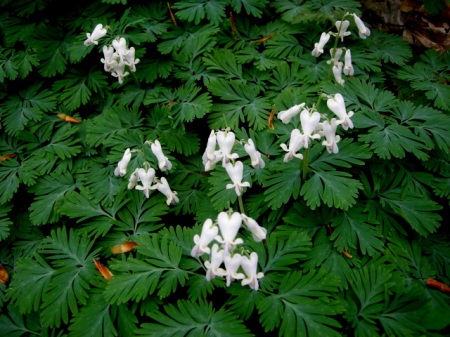 squirrel-corn, Dicentra canadensis
squirrel-corn, Dicentra canadensis
.
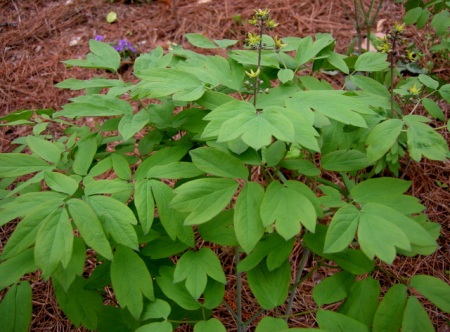 Blue cohosh, Caulophyllum thalictroides, has these unprepossessing flowers in the spring followed by bright blue berries. I love its leaf and stem structure and elegant overall habit.
Blue cohosh, Caulophyllum thalictroides, has these unprepossessing flowers in the spring followed by bright blue berries. I love its leaf and stem structure and elegant overall habit.
.
 Blue cohosh can act like a small shrub, here with an underplanting of squirrel-corn.
Blue cohosh can act like a small shrub, here with an underplanting of squirrel-corn.
.
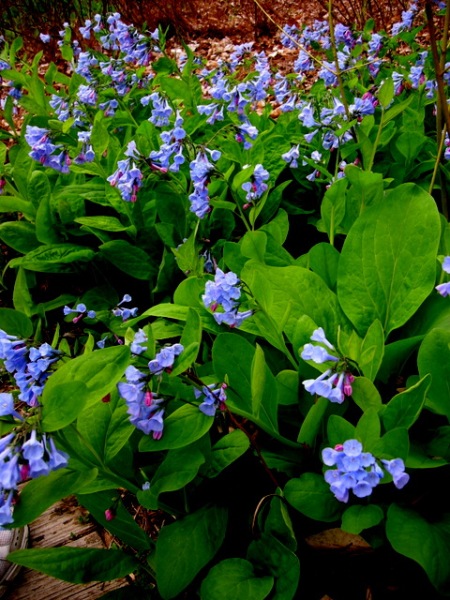 Virginia bluebells, Mertensia virginica, were everywhere just like they are in my own garden where they seed prolifically.
Virginia bluebells, Mertensia virginica, were everywhere just like they are in my own garden where they seed prolifically.
.
 Eastern false rue-anemone, Enemion biternatum, is a new plant to me. I am going to look for it though because its flowers were lovely perched on reddish stems and it evidently spreads to make an eye-catching patch.
Eastern false rue-anemone, Enemion biternatum, is a new plant to me. I am going to look for it though because its flowers were lovely perched on reddish stems and it evidently spreads to make an eye-catching patch.
.
 I thought what Longwood had done to the stump of a tree that came down was very interesting and actually quite attractive.
I thought what Longwood had done to the stump of a tree that came down was very interesting and actually quite attractive.
.
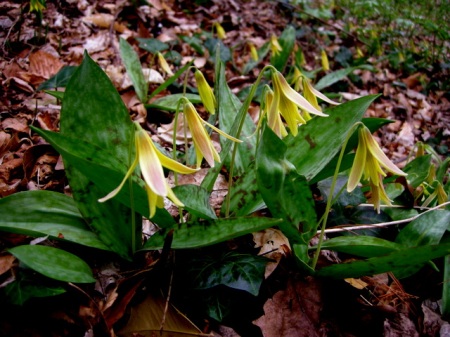 Adder’s tongue or what I call trout lily, Erythronium americanum, usually produces hundreds of leaves and a few flowers in my garden, but this year it is blooming well everywhere.
Adder’s tongue or what I call trout lily, Erythronium americanum, usually produces hundreds of leaves and a few flowers in my garden, but this year it is blooming well everywhere.
.
 The emerging fronds of Christmas fern, Polystichum acrostichoides, look like fairies should be dancing among them.
The emerging fronds of Christmas fern, Polystichum acrostichoides, look like fairies should be dancing among them.
.
 Sensitive fern, Onoclea sensibilis, is a great native fern that is underused in gardens.
Sensitive fern, Onoclea sensibilis, is a great native fern that is underused in gardens.
.
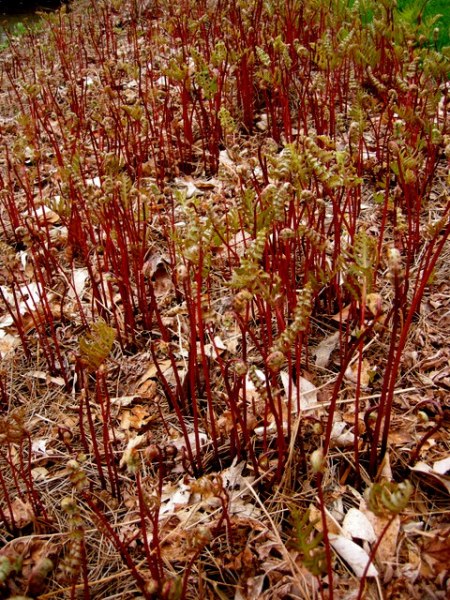 Sensitive fern looks great in a mass planting.
Sensitive fern looks great in a mass planting.
.
 The wind was roaring when I tried to photograph these spring-beauties, Claytonia virginica, so they are out of focus, but I didn’t want you to miss them.
The wind was roaring when I tried to photograph these spring-beauties, Claytonia virginica, so they are out of focus, but I didn’t want you to miss them.
.
 Spring-beauty really has an amazing flower even when blurry.
Spring-beauty really has an amazing flower even when blurry.
.
 Large -leaf waterleaf, Hydrophyllum macrophyllum, has very pretty foliage.
Large -leaf waterleaf, Hydrophyllum macrophyllum, has very pretty foliage.
.
 Cutleaf toothwort, Cardamine concatenata, is a spring ephemeral that naturalizes slowly to form a colony in the shade.
Cutleaf toothwort, Cardamine concatenata, is a spring ephemeral that naturalizes slowly to form a colony in the shade.
.
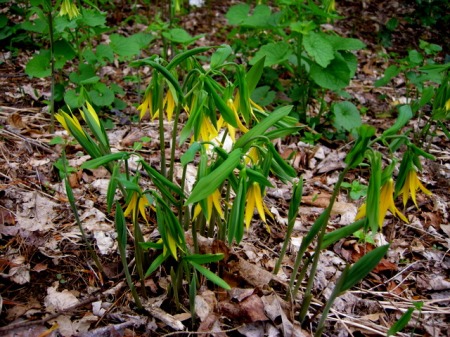 Large-flowered bellwort, Uvularia grandiflora, is one of my favorites. It grows 1 to 2 feet tall, has unusual and elegant yellow flowers, and grows in full, dry shade. I don’t know why this plant isn’t more popular, but it doesn’t sell well at my nursery even though I have big stands of it in my display gardens.
Large-flowered bellwort, Uvularia grandiflora, is one of my favorites. It grows 1 to 2 feet tall, has unusual and elegant yellow flowers, and grows in full, dry shade. I don’t know why this plant isn’t more popular, but it doesn’t sell well at my nursery even though I have big stands of it in my display gardens.
All the plants profiled are native to Pennsylvania and the East Coast. If you would like to see if a plant is native to your state, the best place to look is the USDA Natural Resources Conservation Service Plants Database. All you do is put in the name of the plant and you will be shown a map of where it is native in the U.S. I also have all these plants in my garden except toothwort and false meadow-rue, and I highly recommend them.
To read more about Longwood Gardens, follow these links:
Groundcovers, Thinking Outside the Box
Longwood Gardens Part 2: At Night
Cold Weather Antidote: Longwood’s Orchids
Carolyn
.
Carolyn’s Shade Gardens is a retail nursery located in Bryn Mawr, Pennsylvania, US, zone 6b. The only plants that we mail order are snowdrops and miniature hostas and only within the US.
If you are within visiting distance and would like to receive catalogues and information about customer events, please send your full name and phone number to carolynsshadegardens@verizon.net. Subscribing to my blog does not sign you up to receive this information.
Nursery Happenings: The 2013 Spring Shrub Offer is now in full swing and orders are due May 18. To read about the plants available and place an order, click here. The 2013 Miniature Hosta Mail Order Catalogue, containing choice selections of miniatures for shipping all over the US, is now on the right sidebar here, and we are ready to ship. If you are local, you can use the catalogue to see what miniatures are available at the nursery.
Facebook: Carolyn’s Shade Gardens has a Facebook Page where I post single photos, garden tips, and other information that doesn’t fit into a blog post. You can look at my Facebook page here or click the Like button on my right sidebar here.
Notes: Every word that appears in orange on my blog is a link that you can click for more information. If you want to return to my blog’s homepage to access the sidebar information (catalogues, previous articles, etc.) or to subscribe to my blog, just click here.
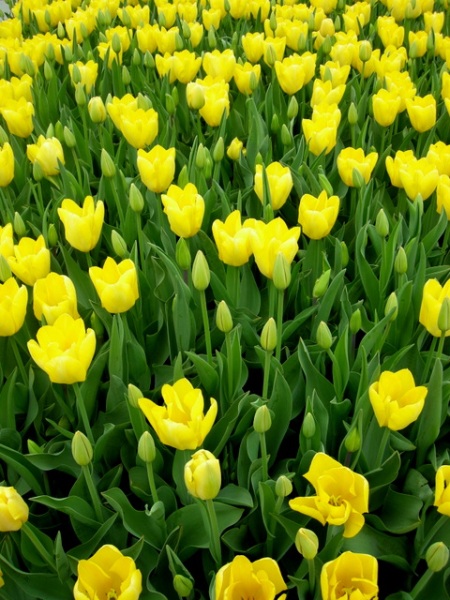




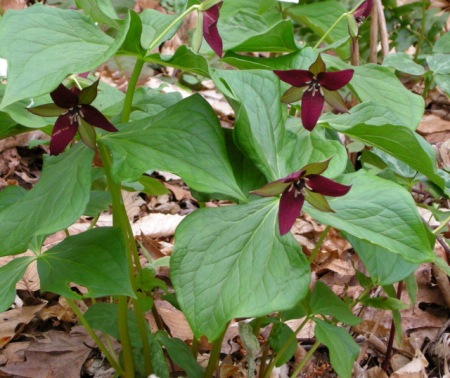
May 2, 2013 at 7:53 am
So many of my favorite natives and many blooming…sad to hear people don’t plant more of them…..my trout lily are flowering even more this year as they grow back in the meadow. I hope to visit Longwood in the future and will make sure I go in April to see these incredible tulips…what a job planting them all…and I love the Lemon Wave foliage.
May 2, 2013 at 9:24 pm
Donna, I would love to take you to Longwood in April. If you like tulips, it’s the place to go. Carolyn
May 2, 2013 at 8:00 am
Longwood is so beautiful in Spring. I love the drifts /beds of colorful tulips. I hope to get there in a couple of weeks, but with the weather, the tulips will be gone. I am surprised you have cool, stormy weather though. We are in the seventies and it is sunny. I can imagine you kneeling down in the wind too!
May 2, 2013 at 9:26 pm
Donna, The tulips will be gone but there will be something just as amazing to take their place. We are finally getting some sunny, warmer weather after it rained for 24 hours on Monday. Carolyn
May 2, 2013 at 8:42 am
Thanks so much for taking us to Longwood! I am always much too busy with projects to visit any gardens in spring, so that was a real treat. I have so enjoyed your posts, and appreciate how much time goes in to them. All the best, Barbara
May 2, 2013 at 9:28 pm
Barbara, Thanks for your kind words—a lot of time does go into each post. I need to get off the property occasionally or I would go insane. Carolyn
May 2, 2013 at 8:45 am
The things we do for good photographs! I can picture you in the freezing cold. Yikees! I’d love to visit this garden with you one day. You know so much about it and all the plants. Wow on the vista and Yellow Wave tulip. Very beautiful and unique. That stump is really neat! Did they stain it after they cut it like that?
May 2, 2013 at 9:31 pm
Tina, The wind was the worst because I am generally not the most patient of people but there is no point in taking the photo when the plant is moving. I have spent so much time at Longwood that I know many parts of it by heart. I would love to show it to you. Michael doesn’t think that the stump was stained. Carolyn
May 2, 2013 at 10:04 am
325 acres! Wow- I didn’t realize! Too bad the weather was so uncooperative when you visited. I love the ferns – the shot of the Christmas fern is just magical. I also liked seeing those ostrich ferns. I bet it is impressive when they have filled out.
May 2, 2013 at 9:33 pm
Holley, 325 acres is just a small part of Longwood’s total holdings. They own so much land that they actually moved a state highway from one location on their property to another. Carolyn
May 2, 2013 at 12:16 pm
As always, I admire your energy, humor, and love of plants. We are so lucky to have Longwood Gardens so close to home. Thanks for sharing what must have turned out to be a miserable day, weather wise, but eye candy, otherwise. I just started replanting my daffodils last night, and now I see I have to move even more to make room for more native plants….a gardener’s work is never done! Thanks for all your continual information and inspiration!
May 2, 2013 at 9:34 pm
Bonnie, It is so nice to hear from you on the blog. I loved seeing the natives but am sad I didn’t get back when the woods were really out. Maybe I’ll still make it. Carolyn
May 2, 2013 at 6:32 pm
Yes, we definitely like the same flowers. I love Uvularia grandiflora!
May 2, 2013 at 9:35 pm
Karen, The silver lining of my customers not buying plants is that I plant them in my woodland. I have a lot of big beautiful clumps of uvularia! Carolyn
May 2, 2013 at 7:17 pm
What lovely Trout Lilies. aren’t they also known, for some inexplicable reason, as Dog Tooth Violet? Thanks for the good ideas and excellent pictures. I have this fantasy about having mostly native plants rather than my bumper crop of poison ivy.
May 2, 2013 at 9:37 pm
Hillsmom, Dog tooth violet is the common name for some types of Erythronium and maybe this one. Common names are very confusing. Poison ivy is native :-). Carolyn
May 2, 2013 at 9:34 pm
I have changed my tune on Tulips this spring. I never liked them much before as garden plants, but if you think of them color accents they are not as bad.
May 2, 2013 at 9:39 pm
Les, I am perfectly happy to view masses of tulips in other people’s gardens and at Longwood. For my own garden, I have the Darwin hybrid tulips that my children planted when they were little. They come up sparsely in ones and twos and that’s the way I like them. Carolyn
May 3, 2013 at 12:37 am
Absolutely beautiful, I couldn’t pick a favorite if I wanted to. I’m a tad big envious of those gardens, how lovely to be able to visit them.
May 3, 2013 at 9:06 am
Barb, I try not to take for granted how lucky we are in the mid-Atlantic to have some many wonderful public gardens. Carolyn
May 3, 2013 at 6:57 am
True enough, the Tulips, grand as they are, are not what I associate with Carolyns shade garden. The Uvularia grandiflora looks so very interesting and is truly surprising that it is not more popular. Thanks for telling me of the problem you had viewing my pictures. I can’t find any reason for this, if I have any other visitors saying the same thing, I will let you know.
May 3, 2013 at 10:33 am
Carolyn, what a lovely place to visit. Thank you for adding the history behind the place. For someone unfamiliar with the area, it’s nice to learn the history.
I know that many of the plants you have highlighted are native to the Eastern States – I have to tell you that this spring I have planted Anemonella Thalictroides and Dicentra culcullaria in my garden. They are lovely little woodlanders!
I’m interested to know why you call the Dicentra Squirrel Corn. I have only ever heard the common name Dutchman’s Breeches being used.
May 3, 2013 at 1:57 pm
Angie, That was a typo. It was supposed to be Dicentra canadensis, squirrel corn, not Dicebtra cucullaria, Dutchman’s breeches. I am goingto fix it. Thanks, Carolyn
May 3, 2013 at 2:33 pm
Such a lot of lovely woodlanders and those tulips – wow! I treied growing Uvularia twice, but it died on me both times unfortunately. You ask why people don’t buy it in your nursery, could it be because the leaves and petals are always twisted and therefore the plant doesn’t look very happy? If they don’t know that this is how it should be, maybe it puts them off.
May 3, 2013 at 11:32 pm
Carolyn, thanks for yet another great and informative post from you, and thanks for braving the cold and windy weather – what don’t we endure to get our photos, huh?
I must admit seeing tulips like that makes me want to plant tulips in my whole garden, so I can enjoy some of the same kind of mass planting, it looks so lovely on such a grand scale. Not sure if my wallet would agree though… on the other hand, if I should really splash out money on some plants, I still have several trilliums on my wish list that I really, really would like to have. Shame they cost so much, and you really need more than one of each….maybe next year, I have already bought many more plants than I should have this year!
May 4, 2013 at 4:40 am
What a wonderful selection of woodsy plants, it must make everyone want a woodland of their own! The tulips are really “wow” such a blaze of colour, I will just have to admire them from afar, I have to grow them in pots as my soil is too wet all winter. Thank you for sharing your visit with us.
May 4, 2013 at 5:35 pm
Such a beautiful place! Thank you for braving the wind and rain to bring us these photos! I love all the delicate woodland flowers. The trout lilies are really beautiful.
May 6, 2013 at 3:11 pm
It is very frustrating when the sun goes and the wind comes when you want to photograph plants. But it doesn’t show. Your photographs are beautiful.
May 6, 2013 at 9:19 pm
How wonderful that the place was purchased specifically to preserve the trees. Mature native trees can be such a rarity. I was particularly taken with that false rue-anenome. very pretty.
May 7, 2013 at 3:47 pm
Love that ‘Miracle’ coral bells, what a beauty. Is your sensitive fern a cultivar? I grow this fern too but the stems are green and not that fantastic red.
May 7, 2013 at 6:34 pm
Patty, the sensitive fern was at Longwood and there was no cultivar listed on the label. Mine has red stems but I will have to check and see how red. Carolyn
May 8, 2013 at 2:00 pm
I only ever got to visit Longwood while on a business trip in mid-winter but the greenhouse experience was incredible, most noticeably the acacia covered walkway in full bloom. Now I’m paralyzed, I won’t be going back but this is why I so treasure these types of travel posts. The one garden I wish I could have visited is most definitely Chanticleer.
May 9, 2013 at 7:05 pm
Patrick, It is very gratifying for me that I am able to take you to gardens that you can’t visit on your own. Have you seen the book on Chanticleer? the photography is amazing. Carolyn
May 9, 2013 at 3:55 pm
[…] Longwood Gardens Part 5: Tulips and Natives (carolynsshadegardens.com) […]
May 10, 2013 at 1:26 pm
Carolyn – What a treat! Your natives are so unusual to me. You certainly wouldn’t want to encounter a rococo tulip while walking alone in the woods.
May 10, 2013 at 4:26 pm
Bag, That’s what I thought—how can a tulip look dangerous?!? Carolyn
May 10, 2013 at 10:46 pm
Those Tulips are incredible, and of course the Trilliums are lovely. What a wonderful idea to visit a garden in different seasons! Thanks for taking us along!
May 11, 2013 at 12:04 pm
Oh all those darling wildflowers, so many new to me! I’m making a list… I’m with b-a-g about that tulip though.
May 11, 2013 at 4:20 pm
Linnie, I thought of you when I wrote about the tulip. It looked like your kind of plant. Carolyn
May 19, 2013 at 9:34 am
I bought some Blue cohosh, Caulophyllum thalictroides locally, but did not come home with a clear idea of where to plant it. Now that I have read your profile, I have a better idea. I also saw Large-flowered bellwort, Uvularia grandiflora when I was at the nursery and will have to go back for it after reading it is one of your favourites.
May 19, 2013 at 8:09 pm
Jennifer, I really like both of those plants but neither are big sellers. Carolyn
May 24, 2013 at 8:17 pm
Despite the cold and the rain, you got many good pictures of beautiful woodland flowers. I have some wild Uvularia that pops up around my compost bin, but I would love to have a mass of Uvularia grandiflora growing in a woodland garden (along with many of the others you’ve highlighted here). Still more inspiration for me to start such a garden along the wooded side of the driveway. I’m flagging this post for inspiration and information when I finally get to that project. Thanks.
May 24, 2013 at 8:34 pm
Jean, So glad you liked the native plants in the post. Are you retired and on your way to Maine? If so, congratulations. Carolyn
May 24, 2013 at 8:36 pm
Alas, I still have one more year of teaching before I can retire — but I am in Maine (where it is cold and rainy and the grass is so tall that I’m going to need haying equipment to deal with it if I can’t get out to mow soon).
May 25, 2013 at 7:31 am
It was 46 degrees here yesterday and pouring so it is not much better. Today it is sunny and 50.
August 23, 2013 at 9:37 pm
Can you please tell me if there is any tulip that can be planted in part shade or full shade
August 24, 2013 at 8:51 am
Tulipa sylvestris